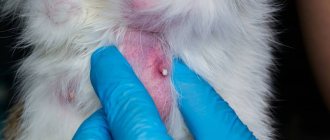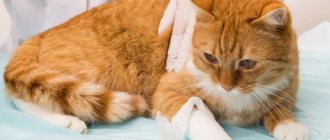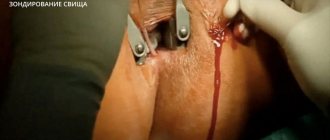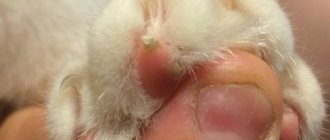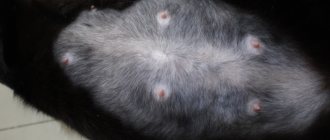The appearance of subcutaneous lumps on the body of a pet is an alarming sign that requires mandatory diagnosis. The wide variety of possible causes precludes any attempt at self-treatment. An incorrectly selected technique can harm the pet and worsen its well-being.
Despite the danger of possible consequences, do not panic. Many neoplasms are benign. For an accurate result, a thorough examination at a veterinary clinic will be required.
Types of bumps on cats' paws and their causes
Despite the fact that the types of bumps on cats’ paws and their causes vary greatly, even a not very “veterinarian” owner, after taking a good look, will be able to at least roughly guess the nature of the neoplasm and how urgently it is necessary to seek veterinary help.
Main pathogenic factors:
- Cones of purulent origin. If a splinter (grass stubble, for example) gets under the skin on the paw, then the pathogenic and conditionally pathogenic microflora located on its surface gradually causes inflammation. However, an abscess that appears as a result of bites is much more typical. Because there is no access to oxygen; over time, a lump filled with purulent exudate forms in this place.
- Pyoderma, which occurs as a result of severe deterioration of immunity and contamination of the skin with streptococci or staphylococci. However, neoplasms with pyoderma rarely develop to the point of large lumps. As a rule, such “pimples” are no larger in size than a large cherry. In addition, they are numerous, and therefore it is extremely difficult to mistake them for a single cone.
- Strong blows ending in the formation of a hematoma. In these cases, small (and other) blood vessels “explode” under the skin, as a result of which the newly formed cavity is gradually filled with blood. A separate and rare variety is “lymphotomes”, i.e. similar neoplasms that appear as a result of damage to the lymphatic vessels. If the skin is damaged, the hematoma may be complicated by the development of purulent inflammation.
- Edema. Such bumps also appear suddenly, and they are not easy to detect visually. Much more often their appearance is diagnosed by palpation of the cat's paw.
- Benign neoplasms (tumors). They are generally quite soft and slow growing. Most often, they appear in old cats, and their occurrence cannot be called rapid: such tumors can grow for years.
- Cases of the formation of large warts and papillomas can be considered a type of benign formations. They bear little resemblance to “typical” cones, since in this case there is a clearly defined neck and body of the neoplasm, which is why the latter often dangles on the cat’s paw, resembling a small, leathery “pendulum.”
- Malignant neoplasms (cancer). In this case, the tumors are tougher, grow many times faster, and sometimes their appearance takes several weeks. This reason for the formation of cones is extremely dangerous, because... Through metastasis, tumors can quickly spread throughout the body.
- Poisonous insect bites, poisonous herb burns. Of course, such cones are found either only in the summer, or exclusively in the southern regions. They arise spontaneously, very quickly. Often accompanied by the development of allergic reactions. If the dose of poison was large, or if the cat is susceptible to the poison that entered its body, the pet may well die.
- If the lump appears somewhere in the area of the fingers, you can suspect that the animal has a fungal or yeast infection (malasseziosis, for example). In cats, such diseases are somewhat less common than when compared with dogs, but such cases do exist. A characteristic sign of these ailments is a sharp, specific smell. Sometimes it resembles the aroma of cheese or mold, but sometimes the paws of a sick cat can noticeably “smell” like old socks.
- Lumps of a cystic nature. Typically, cysts (fluid-filled blisters) appear in internal organs, but there are also more rare cases of their formation on the paws or other surfaces of the body. They grow rather slowly, but their appearance causes a lot of trouble for the animal: they hurt a lot, itch, which is why the cat constantly scratches them or even chews them until they bleed. This process is often supplemented by the participation of pathogenic pyogenic or necrotic microflora.
- Lump in the joint area. In most cases, this happens either after severe injuries (falls, bruises, a cat falling under the wheels of a vehicle), or against the background of old, advanced cases of arthritis and arthrosis. In this case, the cat’s joint capsule is destroyed, and the synovial fluid immediately or gradually flows under the skin. The process is similar to the principle of hematoma formation.
- The lump may be a consequence of edema, including an allergic nature. Considering that even relatively harmless urticaria can cause anaphylactic shock, it is better to immediately show the cat to a veterinarian.
- Finally, the lump can develop from the inside, i.e. be the result of growths on the bone itself. This can be a consequence of poorly healed fractures, or, what is much worse, it can be a sign of sarcomas, osteoblasts and other oncological pathologies of bone tissue.
Precautionary measures
If the lump under the skin turns out to be a tick, contact your veterinarian immediately. The most dangerous parasites carry encephalitis, so if treated independently, not only the cat, but also the owner may suffer. First aid is recommended only when an urgent visit to a veterinary clinic is not possible. To do this, strictly follow the instructions for removing ticks. If you don’t know her, contact your doctor by phone. Improper removal may result in blood poisoning.
Never squeeze out cones with purulent contents. Damage to such seals leads to infection of deeper layers of cellular tissue and a severe form of abscess.
In the later stages of cancer, the likelihood of saving the animal is minimized. If you want to protect your sick pet, sign up for a veterinary clinic for diagnosis immediately after detecting subcutaneous lumps.
First aid and treatment for cats
As a rule, first aid and treatment of a cat in such cases is the prerogative of a veterinarian. We can advise the owners themselves the following:
- It is necessary to immediately provide the animal with complete rest; if necessary, it should be isolated from other pets and small children.
- If the lump has formed suddenly, you can apply cold in the first half hour to an hour. Do not use warming or cooling ointments.
- To make paw care and treatment easier, you can clip the hair around the coat.
- If pus or other exudate is released from the neoplasm, it must be regularly removed from the skin.
Diagnostic methods
If the owner notices that bumps have appeared on the neck of a cat or kitten, it is necessary to urgently take the animal to the veterinarian. The doctor will conduct an initial examination and ask the owner about the pet’s behavior and whether any changes have been observed in its habits. Sometimes palpation alone is not enough to determine an accurate diagnosis. Therefore, a number of additional diagnostic studies are prescribed. Often these are cytological and histological analyzes that help determine the internal composition of the neoplasm and its nature.
Prevention and hygiene of animal paws
Prevention and hygiene of cat paws plays an important role:
- If your pet is walking outside, it doesn’t hurt to inspect its paws from time to time. If they are dirty, wash them with warm water and baby soap.
- Cats should be given the opportunity to naturally grind down overgrown claws (using scratching posts). If this is not possible, overgrown claws are trimmed from time to time.
- The pet should be vaccinated in a timely manner and undergo a preventive veterinary examination at least once a quarter.
What to do to get rid of the tumor?
Enlarged formations are subject to mandatory removal.
If the lump on the nose, near the ear or neck is benign, stable and does not bother the animal, the veterinarian will advise simply observing it. Sometimes such tumors resolve on their own, without special treatment. The growths, which gradually grow and compress the surrounding tissues, are removed surgically using local anesthesia. To prevent infection in the postoperative period, a course of antibacterial therapy is required.
A common method for removing tumors of benign etiology is freezing with liquid nitrogen. This method is preferable for an old pet, because it will help minimize trauma.
If a cat has a lump on its neck that is malignant in nature, and the disease is diagnosed in a timely manner, surgical removal is prescribed, during which nearby tissues are also excised. This way, it will be possible to get rid of cancer cells and prevent relapse. Ancillary antitumor therapies such as chemotherapy and radiation are extremely rarely prescribed to cats. After surgery, a restorative treatment regimen is selected for the animal.
2.Classification
Keratomas are classified according to a number of characteristics:
- senile keratoma (gray-white growth on an open area of the body, prone to inflammation);
- seborrheic keratoma (the most dangerous type of growth, which turns brown over time, causes itching and peeling);
- horny keratoma (usually a strongly protruding, small diameter, but tall, dark-colored growth that can degenerate);
- solar keratoma (multifocal keratoma, most often affecting exposed skin in men over 40 years of age, dangerous for asymptomatic degeneration into cancer);
- follicular keratoma (growth on the scalp or upper lip, more common in women).
Visit our Dermatology page
Signs of development of adenoma of the perianal glands
Adenoma of the perianal glands in cats is a benign neoplasm of the exocrine glands located in the perianal region. Most often, the pathology develops in uncastrated cats, but it can also occur in sterilized cats.
The causes of the appearance of adenomas of the perianal glands in animals are tumor processes in the ovaries, testes, adrenal glands, hyperadrenocortisimsis, obesity, old age and heredity.
Signs of the development of perianal gland adenoma in cats are the following symptoms:
- Formation of single or multiple lumps in the anus;
- Hair loss and redness of the skin in the affected area;
- Pain in the perianal area and tail;
- Increased thirst and urination;
- Decreased appetite or refusal to feed;
- Aggressive behavior;
- Swelling of the skin in the tail and hind legs;
- Difficulty urinating and defecating;
- Exhaustion.
Furuncle
This is not just an abscess - inflammation of the epithelium, but a disease (in acute or mild form) caused by decreased immunity and focal damage to the hair follicle. It is purulent and necrotic in nature, caused by white or aureus staphylococcus, and begins with a red tubercle:
Gradually, the sore increases, fills with pus, becomes painful, body temperature rises, apathy and loss of appetite are possible. The lesions affect some or all parts of the body, or isolated ones.
Under the skin, the pus is located, as it were, in a “vessel” that restrains the boundaries of inflammation, and after “ripening” one (or several) gray dots will be visible from above - the rod.
Do not squeeze out the boil! Otherwise, the pus will spill over the adjacent tissues.
The veterinary clinic will do everything you need, and in the case of a chronic form, they will prescribe antibiotics.
Keep a sick animal especially clean by placing disposable diapers on top of the bedding every day. Don't bathe! Trim the fur from the site of inflammation, apply ichthyol ointment or Vishnevsky, wipe with alcohol while changing the compress, give an anesthetic. In case of spontaneous opening of the sore, clean it as much as possible from pus (do not press!) and reapply a bandage with ointment, changing it every 4-6 hours until the wound is completely cleansed.
Abscesses
An abscess is a pus-filled, swollen spot on the skin that sometimes forms at the site of a cat bite or scratch. They are often red and painful, so your cat may shy away from your touch.
Cats with an abscess may appear more tired than usual and may not show much interest in eating. A warm compress may give them relief.
To treat an abscess, your veterinarian may prescribe an antibiotic and an anti-inflammatory medication for your cat. They may also trim the hair around the bump to keep the wound clean. If the abscess is deep, your cat may need surgery.
Symptoms of diseases
Of course, a doctor can make a correct diagnosis, but if the lump on the cat’s back is soft, then, most likely, cancer can be ruled out. A hard bun that changes shape and size should cause great concern. Regarding color, homogeneous smooth tumors of a brownish or yellowish tint may indicate purulent accumulations under the skin. You cannot open them yourself at home. In this way, enormous harm can be caused to the animal, which is then difficult to correct.
In parallel with the swelling, there may be severe itching or pain. If your pet is trying to pick a lump, is irritable, has poor appetite and has a fever, then you need to consider the option of demodicosis (subcutaneous pimple) or a purulent abscess. Malignant tumors can also cause loss of appetite, vomiting, and lethargy. The furry friend becomes lazy and weak, refusing to do what he used to like.
Some bumps are not accompanied by any pain, changes in behavior or other symptoms. As a rule, such formations do not cause any harm or negative consequences, but still, it would not be superfluous to clarify this point with a veterinarian.

